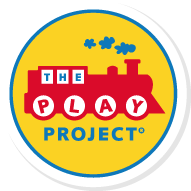 By: Sheryl Rosin Ph.D.,CCC-SLP; P.L.A.Y. Project Home Consultant
By: Sheryl Rosin Ph.D.,CCC-SLP; P.L.A.Y. Project Home Consultant
Nova Southeastern University
Ft. Lauderdale, FL. 33314
Approximately 25% of children with ASD are nonverbal. Augmentative and Alternative Communication (AAC) supports provide the child with a way to express his or her wants and needs, engage socially, and communicate more effectively. The use of AAC during P.L.A.Y. sessions assists the child in opening and closing circles and in initiating ideas for activities with their P.L.A.Y. partners.
The reason that AAC is effective is that many individuals with ASD are visual learners. Visuals are used in many AAC systems. The most common visual is a picture communication symbol (PCS). By using PCS, we can take advantage of this strength and help individuals with ASD understand and produce language easier.
There are many different types of AAC. Some are “no-tech” and do not require anything beyond the user’s body. Others are “low-tech” and require something external to the user that may be non-electronic or a simple electronic device. “High-tech” types of AAC are electronic devices similar to computers. There is no one best AAC for all children with ASD. The key is matching the child’s individual strengths and needs with the most appropriate type(s) of AAC.
 Here is an example of a child using “no-tech” AAC to build vocabulary and open circles during a “Stop and Go” activity during his P.L.A.Y. session. The child begins bouncing on the couch. The P.L.A.Y. partner joins him and bounces up and down dramatically alongside. Hair is flying and silly noises are made as the partner and the child bounce together. The child loves the movement and watches this silly scene as the P.L.A.Y. partner moves about. Intermittently, the partner stops bouncing and says/points to the “STOP” PCS. The partner looks at the child expectantly and waits for the child to open a circle. Soon, the child points to the “GO” PCS in order to direct the partner to bounce once again. Through the use of the AAC below, the child opens and closes many circles by leading the partner to “stop” and “go” throughout this activity.
Here is an example of a child using “no-tech” AAC to build vocabulary and open circles during a “Stop and Go” activity during his P.L.A.Y. session. The child begins bouncing on the couch. The P.L.A.Y. partner joins him and bounces up and down dramatically alongside. Hair is flying and silly noises are made as the partner and the child bounce together. The child loves the movement and watches this silly scene as the P.L.A.Y. partner moves about. Intermittently, the partner stops bouncing and says/points to the “STOP” PCS. The partner looks at the child expectantly and waits for the child to open a circle. Soon, the child points to the “GO” PCS in order to direct the partner to bounce once again. Through the use of the AAC below, the child opens and closes many circles by leading the partner to “stop” and “go” throughout this activity.
By introducing AAC into the P.L.A.Y. activity, the child not only shared his attention and engaged with his play partners, but used two-way communication with an appropriate vocabulary in the context of the interaction.
Other uses of AAC support during P.L.A.Y. Project can include choice boards where the child has access to pictures of objects or activities matching his/her comfort zones, sensory profile and functional developmental levels. The child learns to give a picture of a desired object or activity to a P.L.A.Y. partner in return for access to that object or activity of intent. Voila! Initiation begins and the child moves into functional developmental level 3. Over time, the child learns to communicate increasingly complex messages for a variety of functions (e.g., behavioral regulation, social interaction, and joint attention) through the use of AAC while interacting with his/her P.L.A.Y. partner.
Although children using AAC in The P.L.A.Y. Project have been shown to make dramatic improvements in spoken language abilities, caution should be taken that the P.L.A.Y. visit does not turn into a “speech” session comprised of only the ideas/agenda of the P.L.A.Y. partner. Always remember to follow the child’s lead, cues and intent so that the use of AAC enhances and supports the relationship between the PLAYers and the child.
